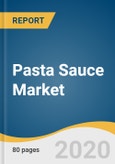Pasta Sauce Market Growth & Trends
The global pasta sauce market size is expected to reach USD 17.33 billion by 2027, expanding at a CAGR of 3.2% from 2020 to 2027. The rapid adoption of pasta as a main course in formal meals among working-class professionals and students is expected to remain a favorable factor for industry growth. Furthermore, an increasing number of vegans and vegetarians across the globe is one of the major factors driving the adoption of vegetable-based pasta sauce.
Consumers have been looking to include only plant-based items in their meals to reduce the impact on the environment as well as support animal welfare. Furthermore, increasing health complications resulting from the regular consumption of meat is compelling for people to opt for a vegetarian diet. Thus, vegetable-based pasta sauce, which includes a wide variety of plant-based ingredients, is expected to drive the market.
Product launches have played a vital role in assisting the wide penetration. For instance, in September 2019, FarmToFork launched its simple, clean label, sustainably grown tomato sauce. These products are non-GMO labeled certified products and they do not contain sugar as well as artificial flavors. The brand offers four flavorful varieties, including marinara, caramelized onion & roasted garlic, tomato basil, and spicy marinara at a retail price of USD 5.99 and USD 7.99.
Tomato-based and marinara pasta sauce dominated the market with a share of more than 25.0% in 2019. The product is expected to maintain its lead in the future owing to its low-calorie content and growing consciousness among consumers regarding including healthier food in a regular diet.
Pasta Sauce Market Report Highlights
The global pasta sauce market size is expected to reach USD 17.33 billion by 2027, expanding at a CAGR of 3.2% from 2020 to 2027. The rapid adoption of pasta as a main course in formal meals among working-class professionals and students is expected to remain a favorable factor for industry growth. Furthermore, an increasing number of vegans and vegetarians across the globe is one of the major factors driving the adoption of vegetable-based pasta sauce.
Consumers have been looking to include only plant-based items in their meals to reduce the impact on the environment as well as support animal welfare. Furthermore, increasing health complications resulting from the regular consumption of meat is compelling for people to opt for a vegetarian diet. Thus, vegetable-based pasta sauce, which includes a wide variety of plant-based ingredients, is expected to drive the market.
Product launches have played a vital role in assisting the wide penetration. For instance, in September 2019, FarmToFork launched its simple, clean label, sustainably grown tomato sauce. These products are non-GMO labeled certified products and they do not contain sugar as well as artificial flavors. The brand offers four flavorful varieties, including marinara, caramelized onion & roasted garlic, tomato basil, and spicy marinara at a retail price of USD 5.99 and USD 7.99.
Tomato-based and marinara pasta sauce dominated the market with a share of more than 25.0% in 2019. The product is expected to maintain its lead in the future owing to its low-calorie content and growing consciousness among consumers regarding including healthier food in a regular diet.
Pasta Sauce Market Report Highlights
- Based on the product, the alfredo and four cheese segment is expected to witness the fastest growth during forecast years with a CAGR of 4.1% from 2020 to 2027. Growing fondness towards cheese-based items across the globe is leading to increasing demand for the sauce.
- By base, the meat-based segment is expected to witness the fastest growth during forecast years with a CAGR of 3.6% from 2020 to 2027. Benefits pertaining to the consumption of meat and enhanced deliciousness of the sauce due to animal fat are leading to the rapid adoption of such products.
- Asia Pacific is expected to witness the fastest growth during forecast years with a CAGR of 4.7% from 2020 to 2027. Growing consumption of Italian foods in key markets, including China, Japan, and India, is expected to expand the scope of products, including pasta sauce, as a condiment in the near future.
- Europe dominated the market by accounting for over 30.0% share of the global revenue in 2019. Predominant consumption of Italian foods in the region is expected to have a favorable impact on industry growth.
Table of Contents
Chapter 1. Methodology and Scope
Chapter 2. Executive Summary
Chapter 3. Pasta Sauce Market Variables, Trends & Scope
Chapter 4. Consumer Behavior Analysis
Chapter 5. Pasta Sauce Market: Product Estimates & Trend Analysis
Chapter 6. Pasta Sauce Market: Base Estimates & Trend Analysis
Chapter 7. Pasta Sauce Market: Distribution Channel Estimates & Trend Analysis
Chapter 8. Pasta Sauce Market: Regional Estimates & Trend Analysis
Chapter 9. Competitive Analysis
Chapter 10. Company Profiles
Companies Mentioned
- Barilla G. e R. Fratelli S.p.A
- Bertolli
- Conagra Brands.
- CSC Brands LP
- Del Monte Food, Inc
- Frontier Co-op
- International Gourmet Specialties
- Mizkan America, Inc.
- No Limit, LLC
- Trader Joe’s
Methodology

LOADING...








